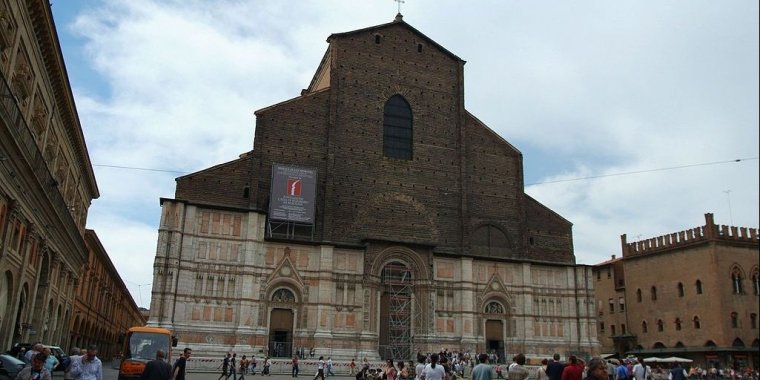| Travel / Tourist Attractions |
Basilica of San Petronio, Bologna, Italy

Basilica of San Petronio, Bologna, Italy. ![]()
The Basilica of San Petronio is a minor basilica and church of the Archdiocese of Bologna located in Bologna, Emilia Romagna, northern Italy. It dominates Piazza Maggiore. The basilica is dedicated to the patron saint of the city, Saint Petronius, who was the bishop of Bologna in the fifth century.
Construction began in 1390 and its main facade has remained unfinished since. The building was transferred from the city to the diocese in 1929; the basilica was finally consecrated in 1954. It has been the seat of the relics of Bologna's patron saint.
The basilica is a large church measuring 132 metres long, 66 metres wide, and 47 metres tall, and is described as the "most imposing" church in Bologna.[3] The facade was designed by Domenico da Varignana and started in 1538 by Giacomo Ranuzzi. However, it remains unfinished.

Basilica of San Petronio - navata centrale. ![]()
The main doorway (Porta Magna) was decorated by Jacopo della Quercia of Siena with scenes from the Old Testament on the pillars, eighteen prophets on the archivolt, scenes from the New Testament on the architrave, and a Madonna and Child, Saint Ambrose and Saint Petronius on the tympanum. It is flanked by two side doors, with Alfonso Lombardi's Resurrection on the left and Amico Aspertini's Deposition on the right.
The central nave covering and apse shooting were completed in 1663, designed by Girolamo Rainaldi and directed by Francesco Martini. The lower naves are enclosed by rectilinear walls. The first two windows were designed by Antonio with the assistance of Francesco di Simone, Domenico da Milano, Pagno di Lapo Portigiani and Antonio di Simone. The bell tower was designed by Giovanni da Brensa and built between 1481 and 1487.
The interior houses a Madonna with Saints by Lorenzo Costa the Younger, and a Pietà by Amico Aspertini.
The altar contains a 15th-century wooden crucifix. At the back, a fresco of the Madonna with St. Petronio by Marcantonio Franceschini and Luigi Quaini, cartoons by Cignani (1672). The ciborium of the main altar was built in 1547 by Jacopo Barozzi da Vignola.
The fifteenth-century wooden choir was completed by Agostino de 'Marchi. The vaulting and decoration of the central nave is by Girolamo Rainaldi, who completed them in 1646-1658.
The nave contains twenty-two side chapels.

Meridian of Giandomenico Cassini. ![]()
The church hosts also a marking in the form of a meridian line inlaid in the paving of the left aisle in 1655; it was calculated and designed by the astronomer Giovanni Domenico Cassini, who was teaching astronomy at the University. A meridian line does not indicate the time: instead, with its length of 66.8 metres (219 ft) it is one of the largest astronomical instruments in the world, allowing measurements that were for the time uniquely precise.
The sun light, entering through a 27.07 mm (1.066 in) hole placed at a 27.07 m (88.8 ft) height in the church wall, projects an elliptical image of the sun, which at local noon falls exactly on the meridian line and every day is different as to position and size.
The position of the projected image along the line allows to determine accurately the daily altitude of the sun at noon, from which Cassini was able to calculate with unprecedented precision astronomical parameters such as the obliquity of the ecliptic, the duration of the tropical year and the timing of equinoxes and solstices.
On the other hand, the size of the projected sun's image, and in particular its rate of variation during the year, allowed Cassini the first experimental verification of Kepler's laws of planetary motion.
Source
• www.wikipedia.org
YOU MAY ALSO LIKE





